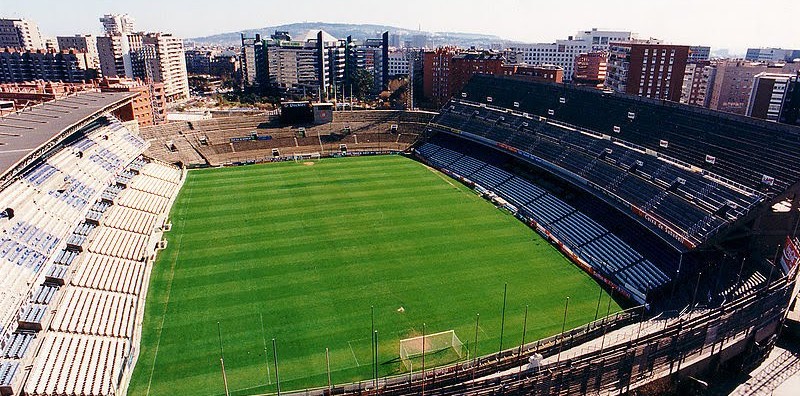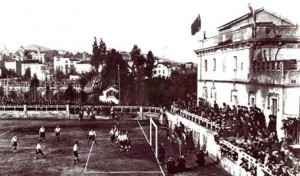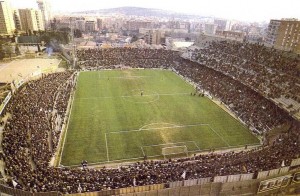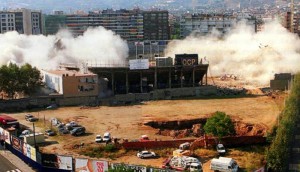- S.D. Eibar ready for maiden La Liga outing
- SD Eibar stengthen ahead of debut La Liga season
- Can ‘Super Mario’ live up to expectations in Madrid?
- MAN IN THE GROUND – Brentford 0 – 4 Osasuna
- Historic Basque derby welcomes S.D. Eibar to La Liga
- Munich to Madrid, via Brazil – Tony Kroos
- Rakitic in Spanish Switch
- Can Spain find redemption in Rio?
- Viva Espana! A season of redemption for Spanish football
- From the old to the new: who can fill the void in years to come for La Roja?
Estadi de Sarrià – The spiritual home of RCD Espanyol
- Updated: 3 November, 2011

By Chris Clements (estadiosdefutbolenespana)
Prior to the advent of day-time television and 2-4-1 offers in the union bar, students could be a resourceful bunch.
Take for example those who formed RCD Espanyol way back in 1900 as a sports club for the Spanish middle classes in an increasingly pro-Catalan Barcelona.
As with many clubs those formative years for Espanyol were at times difficult and not helped by their almost nomadic existence. Between 1900 and 1909 the club underwent four name changes and played at five different grounds.
The original club even went into a sort of hibernation in 1906 when X Sporting Club (no, they really were called X!) took on the footballing duties and made a rather good fist of it, winning the Campionat de Catalunya in successive seasons from 1905-08.
In 1909 the club was relaunched as Club Deportivo Español and a year later adopted their present colours of blue and white stripes.
In 1911, the club moved to Campo de la Calle Muntaner which had been vacated by arch rivals FC Barcelona the previous season, and at the end of the season, they celebrated another win in Campionat de Catalunya.
 Further titles followed in 1915 & 1918, but the truth of the matter was that although Campo de la Calle Muntaner provided them with a stable home, it was very basic and was not a patch on the new stadium that FC Barcelona opened in 1922 in the Les Corts district.
Further titles followed in 1915 & 1918, but the truth of the matter was that although Campo de la Calle Muntaner provided them with a stable home, it was very basic and was not a patch on the new stadium that FC Barcelona opened in 1922 in the Les Corts district.
You can already see a pattern developing, one that shows Espanyol eternally a step behind their neighbours. However, help was at hand in the form of the La Riva Family, wealthy textile industrialists who bought Espanyol some land on
the Carre de Sarrià, deliberately close to Barca’s Les Corts stadium.
The ground was initially called Can Rabia, or White House, after an old villa that stood behind the south goal. Construction began in December 1922 under the supervision of architect Matías Colmenares. The initial plans for the stadium to hold 40,000 spectators had to be downscaled after the construction company went bust.
So with a revised capacity of 10,000, the ground opened on 1 February 1923 with a 4-1 victory over UE Sants. It was a basic affair of banked terracing or bleachers, with Can Rabia still prominent behind the south goal. In 1926 the first stand was erected and in 1928, the first ever goal in the new national league was scored at the ground when “Pitus” Prats scored for Espanyol in a 3-2 over Real Union.
Franco’s government liked to interfere with footballing matters, and in the mid 1940’s he decreed that all club presidents must be nominated by his cronies in Madrid. This did not go down at all well with the La Riva family, who demanded the return of their land.
A protracted dispute ensued, only resolved in 1951 when the club bought the ground for 5 million pesetas. This led to a building spree, with the White House making way for a new south terrace in 1952 and an anfiteatro or raised terrace being added to the west stand in 1956.
This work was conducted by J. Soteras Mauri, the co-architect of the Camp Nou.
The east side was developed in 1974 when an all-seated cover stand was erected, and then in
the
lead up to the 1982 World Cup, 413 million pesetas were splashed out on redeveloping the ground and its infrastructure, raising the capacity to 44,000. Sarria hosted 3 matches, including possibly the greatest game ever played at the finals, Italy’s 3-2 over Brazil.
La Selecion rarely plays in Barcelona, certainly not that often since Franco popped his clogs, but they were welcomed to Sarrià by this pro-Spanish club on three occasions.
Sarrià saw its last international action when it hosted five matches during the 1992 Olympics.
Whilst the Olympics thrust Sarrià into the spotlight once again, it also cast a shadow over the ground thanks to the redevelopment of Estadi Montjuic.
Not wanting an 8500 million peseta white-elephant overlooking the city, the municipality and the Catalan Parliament put pressure on the club to up-sticks and move into the Olympic Arena.
Initially the club and in particular its 18,000 socios resisted, but as the clubs debts rose, selling Sarrià to developers became the only feasible option and on 21 June 1997 it hosted its final match, with Espanyol beating Valencia 3-2. Later that year on the 20 September, the stadium was raised to the ground.
Sarrià was an atmospheric, intense and at times, hostile arena.What a shame that Espanyol’s fans would not experience anything like that for the next 12 years as they headed off to the folly on the hill.
__________________________________
To read more on the footballing stadiums of Spain, visit Chris’s excellent site Estadios de fútbol en España
__________________________________





You must be logged in to post a comment Login